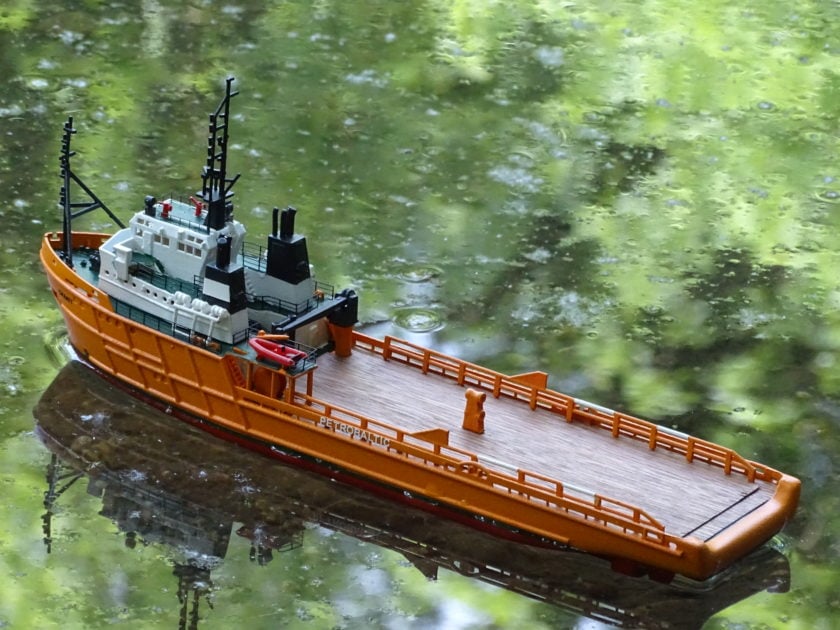A few years ago, the rediscovery of a childhood toy drove Matthias Kreimeyer back to a passion he’d almost forgotten — model RC boats. This time around, Matthias had a chance to use his training as an engineer and a manager at a German carmaker, so he wasn’t limited by mass-produced kits. Soon, his Micro Boat Hobby Shapeways shop was launched from landlocked Munich, owing its origins to kit-built vessels.
Matthias told us about his voyage back to model RC boat building, and how digital design lets him pursue his hobby without needing a workshop.
How long have you been working with model boats?
I used to build model boats as a kid. About three years ago, I was cleaning out my parents’ storage and came across an old boat that had many parts missing. I was mostly wondering if that couldn’t be replaced using 3D printing, and the idea got bigger as I tried out what can be done.
To some degree, this hobby is also a spinoff from my job. I used to work a lot with CAD and with modern engineering data-management systems.
How did you learn to make 3D models?
I am mostly self-taught, though – long ago – my engineering degree brought along a lot of the basics.
But the specifics of design for 3D printing — for example, minimum wall thicknesses — are mostly learned through trial and error and through resources like Shapeways online tutorials.

Initially, the learning curve was definitely quite steep. Nowadays I need to make fewer prototypes.
What kind of 3D modeling software do you use?
For my hobby work, I use only freeware. Mostly FreeCAD, which is very close to professional CAD systems and has a similar logic.
How did you buy or make boats before you discovered Shapeways?
I based my hobby mostly on converting commercial plastic kits. After a little while, however, you have built them all. There are only few kits on the market in my favorite scale (1:200) and my favorite domain (work boats), so if you want to keep things interesting, you have to design your own.
And that’s where there is a niche that I try to fill by making my designs available to other boatbuilders.
How do you decide which projects to work on?
I run a regular discussion with other interested model boat fans through my Facebook page. Sometimes I get specific orders that I work on at the customer’s request, and I get more requests for models than I thought there would be…
I would love to offer more boats in response to individual requests. However, designing a boat does take a lot of time — between 60 and 80 hours, typically — so I mostly try to see what models are interesting to the community.
And sometimes I work on boats only if I feel the design would be a nice addition to my own fleet. I like mostly small boats – both because I have a small apartment and because I am especially interested in the miniaturization of working technology. Hence my designs focus on RC boats that, ideally, feature additional functions.
Where do you find all those design hours?
I mostly do this in my spare time — i.e., on rainy weekends and when my lovely wife is not at home. So I manage to design only two or three boats a year, and my portfolio grows slowly.
Building takes less time than design, but I spread it out more to test components and such. I definitely like the 3D design more than the building and running the boat, though I do take out a boat or two on a lake every now and then, and we usually take one or two on a vacation with us. They are small enough that they fit into the glove compartment.

What has 3D printing added to your appreciation of model RC boats?
You can achieve an excellent level of detail, while the material is strong enough to go out on the pond.
3D printing is also a means to build complex models without having a workshop. With “conventional model boat building,” much happens in a workshop, and my apartment doesn’t have space a workshop (or all the dirt associated with one), as much as I would like one. Today, much of my hobby happens on the balcony, on the couch, or at the kitchen table —and the models actually come out much better and at a more professional level of detail.
Third, the designs can be shared with fellow model-boat builders. I basically try to make available not just the printed parts but also a bill of materials, including photo-etched details, wooden decks, RC components, and color specifications, and a manual to help less experienced model boat enthusiasts.
Tell me about a project you’re particularly proud of.
The little innovations in my boats – particularly my GillJet, a fully functional azimuth thruster at a tiny scale, is part of my Anticosti supply vessel. The maneuverability is really astonishing.
Also my HMCS Kingston model, which has a really good level of detail and is equipped with two fully functional pod drives that can be controlled individually despite being only about 3 by 2 cm each with 3D printed propellers:
Many of my models get featured in the popular German model-boat magazines, which I am very proud of. More articles will appear toward the end of the year.
To learn more about Matthias’ model RC boats, visit the Micro Boat Hobby Shapeways shop, Facebook page, or website. Do you make components for RC boats? Let us know in the comments for a chance to be featured in Shapeways Magazine.







